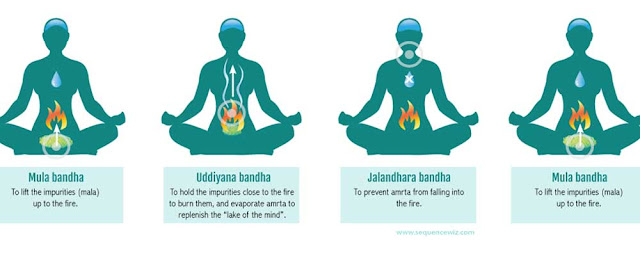 During your regular yoga class, you will commonly hear the instructor call certain Sanskrit terms. As a beginner you may feel lost when such terms are used and you are ignorant of their meanings. Some of those Sanskrit terms may also sound pretty similar but mean totally different things, for example, bhakti and shakti, or dharma and kharma.
During your regular yoga class, you will commonly hear the instructor call certain Sanskrit terms. As a beginner you may feel lost when such terms are used and you are ignorant of their meanings. Some of those Sanskrit terms may also sound pretty similar but mean totally different things, for example, bhakti and shakti, or dharma and kharma.Asana
This refers to a physical posture. The purpose of asanas in yoga is the attainment of a mastery of the body and an enhancement of the body's functions such as:
- Improving energy flow and circulation,
- Expanding muscles and joints;
- Cleansing the various systems of the body (digestive, nervous, reproductive, etc),
- Cleansing organs and
- Creating strength, endurance and balance.
Ashtanga Yoga (eight-limbed union)
- Discipline (Yama),
- Self-restraint (Niyama),
- Postrure (Asana),
- Breath control (Pranayama),
- Sensory Inibition/Withdrawal (Pratyhara),
- Concentration (Dharana),
- Meditation (Dhyana) and
- Ecstacy (Samadhi), respectively.
The ultimate goal of ashtanga yoga is the attainment of liberation/freedom (kaivalya).
Ayurveda
 As per WebMD, Ayurveda or Ayurvedic medicine is one of the worlds oldest holistic (whole-body) healing systems, developed over 3,000 years ao in India. Ayurveda is rooted in the belief that health and wellness are a function of the state of balance existing among mind, body and spirit.
As per WebMD, Ayurveda or Ayurvedic medicine is one of the worlds oldest holistic (whole-body) healing systems, developed over 3,000 years ao in India. Ayurveda is rooted in the belief that health and wellness are a function of the state of balance existing among mind, body and spirit.Bandha (arrest/bond)
This term refers to the
body locks/binds/energetic seals, which are commonly used in a yoga practice. A
bandha is performed in order to regulate and direct energy flow to specific
parts of the body. The four bandhas used in yoga are:
- Mula Bandha - contraction or pulling in of the perineum,
- Uddiyana Bandha - contraction or pulling in of the belly into the rib cage,
- Jalandhara Bandha - tucking the chin into the chest.
- Maha Bandha - maha meaning great.
- This banda is also called the supreme bandha or triple lock, owing to its ability to provide the health benefits of the Mula, Uddiyana and Jalandhara bandhas. The Maha bandha is a simultaneous practice of the aforementioned bandhas.
Guru
The Sanskrit term guru in yoga connotes guide, teacher, expert or master in a certain domain. A yoga student/disciple looks up to their guru as a trusted spiritual guide.
 |
| Sharath Jois (left) and Shri K Pattabhi Jois gurus of ashtanga yoga |
Also called forceful yoga', it is a major branch of yoga that emphasizes the physical aspects of yoga's transformative path, namely:
- Postures (asana),
- Cleansing techniques (shodhana) and
- Breath control (pranayama).
Japa
 Japa refers to the meditative repetition of a divine name or mantra, which is spoken very softly/muttered, just to the hearing of the reciter, or spoken within the reciter's mind. The practice of Japa is believed to cleanse the mind of impurities and results in samadhi.
Japa refers to the meditative repetition of a divine name or mantra, which is spoken very softly/muttered, just to the hearing of the reciter, or spoken within the reciter's mind. The practice of Japa is believed to cleanse the mind of impurities and results in samadhi.Mahatma (great self)
It is an honorific title bestowed upon particularly meritorious individuals who have realized extraordinary exploits in the course of their lives, such as Gandhi (prominently called Mahatma Gandhi.
Mantra
 A mantra is an instrument of the mind, usually a sound or vibration- a powerful one, that a yogi uses to enter a deep state of meditation. In yoga, mantras are the postures of the mind, while asanas are the postures of the body. Mantra is a spiritual practice which should be practiced on a regular basis for an extended period of time (several months) for its benefits or results to set in.
A mantra is an instrument of the mind, usually a sound or vibration- a powerful one, that a yogi uses to enter a deep state of meditation. In yoga, mantras are the postures of the mind, while asanas are the postures of the body. Mantra is a spiritual practice which should be practiced on a regular basis for an extended period of time (several months) for its benefits or results to set in.Matsyendra

Matsyendranatha is traditionally considered the founder of Hatha yoha, and an author of some of its earliest texts. Matsyendra founded the Yogini-Kaula school and is also remembered as a Goraksha teacher. Ardha Matsyendrasana is the asana named after the sage Matsyendranatha.
Mudra
A mudra is a symbolic or ritual gesture and an energetic seal of authenticity which stems from Hinduism. In the yoga practice, mudras are simultaneously used with pranayama, to affect the flow of breath (prana) in the body. There are mainly two types of mudras; hand mudras and whole-body mudras.
Stay tuned for part 2 of the yoga glossary.
Namaste!







Comments
Post a Comment